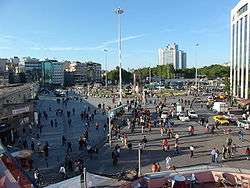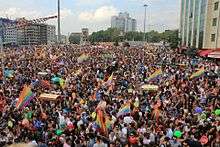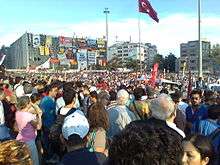Taksim Square
Taksim Square (Turkish: Taksim Meydanı, IPA: [ˈtaksim ˈmejdanɯ]), situated in Beyoğlu in the European part of Istanbul, Turkey, is a major tourist and leisure district famed for its restaurants, shops, and hotels. It is considered the heart of modern Istanbul, with the central station of the Istanbul Metro network. Taksim Square is also the location of the Republic Monument (Turkish: Cumhuriyet Anıtı) which was crafted by Pietro Canonica and inaugurated in 1928. The monument commemorates the 5th anniversary of the foundation of the Republic of Turkey in 1923, following the Turkish War of Independence.
| Taksim Square | |
|---|---|
| Public square | |
 | |
| Features | Republic Monument, Atatürk Cultural Center, Marmara Hotel, |
| Location | Beyoğlu, İstanbul |
| Coordinates: 41°02′13″N 28°59′09″E | |
History

The word Taksim means "division" or "distribution". Taksim Square was originally the point where the main water lines from the north of Istanbul were collected and branched off to other parts of the city (hence the name.) This use for the area was established by Sultan Mahmud I. The square takes its name from the Ottoman era stone reservoir which is located in this area.
Another significant building that once stood on the square was the 19th century Taksim Artillery Barracks (Taksim Kışlası, which later became the Taksim Stadium), but it was demolished in 1940 during the construction works of the Taksim Gezi Park.[1] Taksim Gezi Park is a small green park in the midst of the concrete expanse of central Istanbul. In 2013, the city municipality, wanting to demolish the park to add further shopping venues, began forcefully removing protesters who had set up camp in the park. After news spread of the police brutality, thousands of people rallied in the Occupy Taksim movement, to stop the demolition of the park. As the current status of the demolition project is in limbo, the Justice and Development Party (AKP) government has the Police stationed in and around Taksim Square ready with riot control equipment to deter any large demonstrations.[2]
Present day
Taksim is a main transportation hub and a popular destination for both tourists and residents of Istanbul. İstiklal Caddesi (Independence Avenue), a long pedestrian shopping street, ends at this square, and a nostalgic tram runs from the square along the avenue, ending near the Tünel (1875) which is the world's second-oldest subway line after London's Underground (1863). In addition to serving as the main transfer point for the municipal bus system, Taksim Square is also the terminus of the Hacıosman-4. Levent-Taksim-Yenikapı subway line of the Istanbul Metro.
Taksim's position was given an extra boost on June 29, 2006, when the new Kabataş-Taksim Funicular line F1 connecting the Taksim Metro station with the Kabataş tramway station and Seabus port was opened, allowing people to ascend to Taksim in just 110 seconds.[3]
Surrounding Taksim Square are numerous travel agencies, hotels, restaurants, pubs, and international fast food chains such as Pizza Hut, McDonald's, Subway, and Burger King. It is also home to some of Istanbul's grandest hotels including the InterContinental, the Ritz-Carlton, and The Marmara Hotel. Taksim is also a favourite location for public events such as parades, New Year celebrations, or other social gatherings. Atatürk Cultural Center (Atatürk Kültür Merkezi), a multi-purpose cultural center and opera house, is also located at Taksim Square.
Demonstrations and incidents

The square has been an important venue for political protests during much of its existence. Groups from all sides of the political spectrum in Turkey, as well as many NGOs, try to demonstrate in this square in order to use its visibility for the benefit of their cause.
- On February 16, 1969, some 150 leftist demonstrators were injured during clashes with right wing groups in what is known as "Bloody Sunday".
- In the events known as the Taksim Square massacre, thirty-six left-wing demonstrators were killed by unidentified and allegedly right-wing gunmen on the square during the Labour Day demonstrations of May 1, 1977.
- Taksim Square was the location of football riots in 2000 when two Leeds United fans were stabbed to death during clashes with Galatasaray fans, the night before the 1999-2000 UEFA Cup semi-final first leg match between the two teams.
- On October 31, 2010, a suicide bomb went off next to a police bus. The bomber, a TAK militant, died, while 15 police officers and 17 civilians were injured.[4]
Following many other violent incidents, all forms of group protests were banned in the square and the police units maintained a round-the-clock presence to prevent any incidents. The ban did not apply to surrounding avenues or streets. Today, Taksim Square is once again the starting point or destination of many political demonstrations; moreover, mass meetings on Labour Day were permitted for the first time in 2010 and have been taking place peacefully ever since.
However, gatherings for events such as New Year's Eve, Republic Day celebrations, or mass-screenings of important football matches are excluded from the ban. The annual Istanbul Pride used to take place on the square as well. However, the event has been banned by the Istanbul governor since 2015. [5][6]
Gezi Park protests

In 2013, protests took place in Taksim in opposition to the reconstruction of the Ottoman era Taksim Military Barracks (demolished in 1940 for building the Gezi Park) and a shopping center on the land plot of the Gezi Park.[7] In the early morning of May 31, the Police forces moved in on the demonstrators and people sleeping in tents, and tried to disperse them with tear gas, pepperspray and water cannons.[8][9]
The demonstrators also criticized Prime Minister Recep Tayyip Erdoğan, who has held office for more than ten years, for his uncompromising stance on this controversial issue and for the Turkish police's excessive use of force against the demonstrators.[10]
The large number of trees that were cut in the forests of northern Istanbul for the construction of the Yavuz Sultan Selim Bridge (Third Bosphorus Bridge) and the new Istanbul International Airport[11][12][13][14] (the world's largest airport, with a capacity for 150 million passengers per year)[11][13][15] were also influential in the public sensitivity for protecting Gezi Park. According to official Turkish government data, a total of 2,330,012[16][17] trees have been cut for constructing the Airport and its road connections; and a total of 381,096[16][17] trees have been cut for constructing the highway connections of the Yavuz Sultan Selim Bridge;[16][17] reaching an overall total of 2,711,108[16][17] trees which were cut for the two projects.[16][17][18]
Gallery
 The Marmara Hotel at Taksim Square
The Marmara Hotel at Taksim Square.jpg) Taksim in the 1960s
Taksim in the 1960s- View of Taksim Gezi Park and Levent financial district, as seen from the roof bar of the Marmara Hotel at Taksim, 2009.
 Atatürk Cultural Center at Taksim Square, with the entrance of the Taksim station of the Istanbul Metro.
Atatürk Cultural Center at Taksim Square, with the entrance of the Taksim station of the Istanbul Metro.
References
- "Yok olan İstanbul Taksim Meydanı - Topçu Kışlası yeniden inşa ediliyor!". wowturkey.com.
- "Police disperse protesters with pepper spray to continue partial demolition of Gezi Park". Today's Zaman. 2013-05-28. Archived from the original on 2013-06-23. Retrieved 2013-06-01.
- Taksim-Kabataş funicular subway connection Archived 2007-05-17 at the Wayback Machine
- "Suicide blast hits Istanbul". Al Jazeera. 31 October 2010. Retrieved 31 October 2010.
- "Istanbul police use tear gas to disperse gay pride march | News | DW | 30.06.2019". DW. Retrieved 2020-04-06.
- Gay Pride in Istanbul – The LGBTT Parade Hits Taksim Square! - Turkey - WorldNomads.com. Journals.worldnomads.com. Retrieved on 2013-08-12.
- "Taksim park protests in 4th day amid police crackdown". Hurriyet Daily News. 31 May 2013. Retrieved 31 May 2013.
- The Guardian: Istanbul park protests sow the seeds of a Turkish spring
- New York Times: Peaceful Protest Over Istanbul Park Turns Violent as Police Crack Down
- zeit.de: Eine Ahnung von Tahrir in Istanbul. - Premier Erdoğan lässt Proteste gegen Baumfällungen niederknüppeln. Er agiert mehr und mehr wie ein Despot, die Türken begehren auf. (translated: an idea of Tahrir square. - PM Erdoğan bludgeons down protests against tree felling. He acts more and more like a despot; Turks rebel)
- "Istanbul's New Erdoğan-Backed Airport to Be Named After... Erdoğan". 14 August 2014.
- Today's Zaman: "İstanbul's new airport to be named after Erdoğan"
- Mezzofiore, Gianluca (14 August 2014). "Erdogan Airport: Istanbul's Super Hub 'to be Named After Turkey's President-Elect'".
- "Turkey's largest airport is worthy of Recep Tayyip Erdoğan's name, minister says". Hürriyet Daily News.
- "Dünyanın en büyük havalimanı İstanbul'a yapılıyor". Star. 2013-01-24. Retrieved 2013-01-24.
- "İstanbul'da 2 milyon 700 bin ağaç kesilecek".
- "3. köprü ve 3. havalimanı için 2 milyon 330 bin ağaç kesilecek!".
- "Yeni köprü için kaç ağaç kesildi?".
External links
| Wikimedia Commons has media related to Taksim Square. |